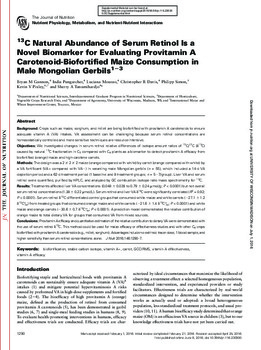Mostrar el registro sencillo del ítem
13C natural abundance of serum retinol is a novel biomarker for evaluating provitamin A carotenoid-biofortified maize consumption in male Mongolian gerbils
| Autor: | Gannon, B.M. |
| Autor: | Pungarcher, I. |
| Autor: | Mourao, L. |
| Autor: | Davis, C.R. |
| Autor: | Simon, P.W. |
| Autor: | Pixley, K.V. |
| Autor: | Tanumihardjo, S.A. |
| Año: | 2016 |
| URI: | http://hdl.handle.net/10883/17150 |
| Resumen: | Background: Crops such as maize, sorghum, and millet are being biofortified with provitamin A carotenoids to ensure adequate vitamin A (VA) intakes. VA assessment can be challenging because serum retinol concentrations are homeostatically controlled and more sensitive techniques are resource-intensive. Objectives: We investigated changes in serum retinol relative differences of isotope amount ratios of 13C/12C (d13C) caused by natural 13C fractionation in C3 compared with C4 plants as a biomarker to detect provitamin A efficacy from biofortified (orange) maize and high-carotene carrots. Methods: The design was a 2 3 2 3 2 maize (orange compared with white) by carrot (orange compared with white) by a VA fortificant (VA+ compared with VA2) in weanling male Mongolian gerbils (n = 55), which included a 14-d VA depletion period and a 62-d treatment period (1 baseline and 8 treatment groups; n = 527/group). Liver VA and serum retinol were quantified, purified by HPLC, and analyzed by GC combustion isotope ratio mass spectrometry for 13C. Results: Treatments affected liver VA concentrations (0.048 6 0.039 to 0.79 6 0.24 mmol/g; P < 0.0001) but not overall serum retinol concentrations (1.3860.22 mmol/L). Serum retinol and liver VA d13C were significantly correlated (R2 = 0.92; P < 0.0001). Serum retinol d13C differentiated control groups that consumed white maize and white carrots (227.1 6 1.2 d13C&) from treated groups that consumed orange maize and white carrots (221.6 6 1.4 d13C&; P < 0.0001) and white maize and orange carrots (230.6 6 0.7 d13C&; P < 0.0001). A prediction model demonstrated the relative contribution of orange maize to total dietary VA for groups that consumed VA from mixed sources. Conclusions: Provitamin A efficacy and quantitative estimation of the relative contribution to dietary VA were demonstrated with the use of serum retinol d13C. This method could be used for maize efficacy or effectiveness studies and with other C4 crops biofortified with provitamin A carotenoids (e.g., millet, sorghum). Advantages include no extrinsic tracer dose, 1 blood sample, and higher sensitivity than serum retinol concentrations alone. |
| Formato: | |
| Lenguaje: | English |
| Editor: | American Society for Nutrition |
| Copyright: | CIMMYT manages Intellectual Assets as International Public Goods. The user is free to download, print, store and share this work. In case you want to translate or create any other derivative work and share or distribute such translation/derivative work, please contact CIMMYT-Knowledge-Center@cgiar.org indicating the work you want to use and the kind of use you intend; CIMMYT will contact you with the suitable license for that purpose. |
| Tipo: | Article |
| País de enfoque: | Mongolia |
| Lugar de publicación: | USA |
| Páginas: | 1290-1297 |
| Número: | 7 |
| Volumen: | 146 |
| DOI: | 10.3945/jn.116.230300 |
| Palabras Claves: | Stable Carbon Isotope |
| Palabras Claves: | Vitamin A+ |
| Palabras Claves: | GCCIRMS |
| Palabras Claves: | Vitamin A Effectiveness |
| Palabras Claves: | Vitamin A Efficacy |
| País: | MONGOLIA |
| Agrovoc: | RETINOL |
| Agrovoc: | MAIZE |
| Agrovoc: | PROVITAMINS |
| Agrovoc: | CARBON |
| Agrovoc: | ISOTOPES |
| Agrovoc: | CARROTS |
| Agrovoc: | BIOFORTIFICATION |
| Datasets relacionados: | https://academic.oup.com/jn/article/146/7/1290/4585786#supplementary-data |
| Revista: | The Journal of Nutrition |
Ficheros en el ítem
Este ítem aparece en la(s) siguiente(s) colección(ones)
-
Genetic Resources
Genetic Resources including germplasm collections, wild relatives, genotyping, genomics, and IP

